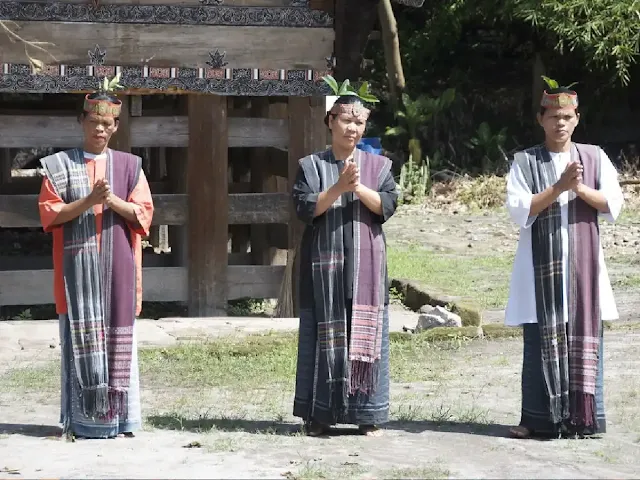 |
| Tortor, The Batak Dance |
Discovery - In the Batak tradition, dance, particularly Tortor, embodies several important elements, serving as a vibrant expression of cultural heritage, spiritual connection, storytelling, ritual practice, and community cohesion. Its rhythmic movements, colorful costumes, and spirited performances reflect the rich tapestry of Batak culture, engaging both participants and spectators in a celebration of shared identity and values.
{getToc} $title={Table of Contents}
From the dawn of human civilization, dance has been an integral part of cultural expression, transcending geographical boundaries and uniting diverse communities around the world. Among the world's oldest cultures, Australian Aboriginals and Native American tribes have preserved ancient dance traditions that date back millennia. For these indigenous peoples, dance is more than a form of artistic expression; it is a sacred ritual that connects them to the land, the spirits of their ancestors, and the natural world. Through rhythmic movements, intricate choreography, and elaborate costumes, Aboriginal and Native American dances recount the stories of creation, the cycles of nature, and the struggles and triumphs of their people.
Just as the Batak people of Indonesia cherish their traditional dances, so too do Aboriginals and Native Americans view dance as a fundamental aspect of their cultural and spiritual heritage. Passed down from generation to generation, these dances embody the collective wisdom, beliefs, and experiences of their respective cultures. They serve as a means of preserving ancestral knowledge, transmitting cultural values, and fostering a sense of belonging within the community. Whether performed during seasonal ceremonies, initiation rites, or social gatherings, these dances serve as a conduit for spiritual connection, social cohesion, and cultural continuity.
In exploring the significance of dance across these ancient cultures, we gain a deeper understanding of the universal human need for creative expression, spiritual connection, and communal celebration. As we delve into the rich tapestry of dance traditions from around the world, we recognize the profound impact that these art forms have on shaping identity, fostering resilience, and bridging cultural divides.
 |
| Tortor Batak Toba - Wiki Common Sigale-gale Huta Bolon Simanindo |
Multifaceted Roles In Storytelling, Rituals, And Community Bonding
Cultural Identity
Dance serves as a vibrant expression of cultural identity, preserving traditions and customs passed down through generations. In indigenous communities like the Batak, dance embodies their heritage, values, and worldview, serving as a form of cultural memory.
Spiritual Connection
Many indigenous dances have spiritual roots, serving as a means to connect with the divine, ancestors, and the natural world. Through rhythmic movements and symbolic gestures, dancers evoke spiritual energies, seek blessings, or express gratitude for the bounty of nature.
Storytelling
Dance is a powerful medium for storytelling, conveying narratives, myths, and legends orally through movement, music, and costume. Each dance gesture and step often carries symbolic meanings, narrating tales of creation, heroes, and historical events.
Rituals and Ceremonies
Dance plays a central role in rituals and ceremonies marking significant life events such as birth, puberty, marriage, and death. These dances invoke divine blessings, purify participants, and foster communal harmony. They also serve as a means of passing on cultural knowledge and values.
Community Bonding
Dancing brings communities together, fostering a sense of belonging and unity. Participation in group dances strengthens social ties, promotes cooperation, and reinforces collective identity. It creates a shared experience that transcends individual differences, fostering solidarity and mutual respect.
Tortor and Gondang
Accompanied by the rhythmic beats of the Gondang, a traditional Batak percussion instrument, Tortor takes on various forms, each with its own significance and purpose.
Gondang Sambilan
Gondang Sambilan, also known as the Nine-Gong Ensemble, is a prominent style of Tortor characterized by its use of nine large gongs. Each gong represents a different aspect of Batak cosmology, from the celestial realms to the earthly domain. The rhythmic patterns produced by the Gondang Sambilan are believed to evoke spiritual energies and bring harmony to the community.
Gondang Sabangunan
Gondang Sabangunan, or the Welcoming Gondang, is performed to greet esteemed guests or mark significant occasions such as weddings and festivals. The lively rhythms and synchronized movements of Tortor dancers reflect the joy and hospitality of the Batak people, welcoming guests with open arms and warm hearts.
Gondang Bolon
Gondang Bolon, the Great Gondang, holds a special place in Batak rituals and ceremonies. As the largest and most sacred of the Gondang ensembles, Gondang Bolon is reserved for solemn occasions such as funerals and ancestral rites. Its deep, resonant tones echo the reverence and solemnity of these rituals, guiding the spirits of the departed to their final resting place.
Gondang Hasapi
Gondang Hasapi, named after the traditional Batak string instrument, is often performed during harvest festivals and agricultural rituals. The melodic strains of the Hasapi, accompanied by rhythmic drumming, celebrate the abundance of the land and give thanks to the spirits of nature for their bounty. Through dance and music, participants express their gratitude and reverence for the earth's gifts.
As guardians of Batak culture and tradition, the Gondang titles associated with Tortor play a vital role in preserving the cultural heritage of the Batak people. With each beat of the drum and movement of the dancers, the spirit of the ancestors lives on, guiding and inspiring future generations to honor their roots and embrace their identity.